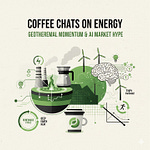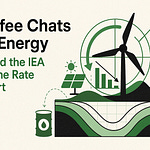Episode Length: ~17 minutes
Episode Summary
In this episode of Coffee Chats on Energy, the hosts dive into the latest in carbon removal, geothermal innovation, AI-driven energy demand, and the evolving policy landscape. From Microsoft’s billion-dollar carbon removal commitments to creative use cases for geothermal heat in Kenya, the discussion highlights how technology, policy, and capital are reshaping decarbonization pathways. The conversation also touches on the role of AI in accelerating workflows and the persistent challenges of CO₂ infrastructure.
Topics Covered
Microsoft & Vaulted Deep Deal
4.9 million tons of CDR offtake, one of the largest permanent carbon storage transactions.
Microsoft’s outsized role as the leading CDR buyer (22M tons of ~24M transacted this year).
Pricing dynamics, with estimates ranging between $200–$500 per ton.
Direct Air Capture & Geothermal in Kenya
Octavia Carbon’s small-scale DAC project using low-grade geothermal heat.
Broader potential for waste heat and geothermal across industries.
U.S. geothermal potential: 29% of the country has >100°C heat at 2 km depth.
AI, Energy Demand, and Workflows
Example of using AI to process geothermal maps, shifting focus from process to outcomes.
AI’s growing energy demand and the race for low-cost, abundant energy.
Policy & Infrastructure (Big Beautiful Bill)
Limited updates but continued interest in credit changes and project economics.
Enhanced oil recovery losing momentum while renewable projects remain viable.
CO₂ infrastructure challenges: pipelines as critical bottlenecks.
Canada’s continued struggles with pipeline development.
Key Takeaways
Microsoft is effectively subsidizing the CDR industry, accounting for nearly all large-scale carbon removal transactions to date.
Permanent carbon storage innovations are diversifying, from organic slurry injection to DAC with geothermal energy.
AI is transforming workflows and energy demand simultaneously—making processes more efficient but increasing the need for cheap, scalable energy.
Heat demand is an overlooked decarbonization frontier—up to 40% of U.S. energy demand is for heating, offering vast potential for geothermal and waste heat applications.
CO₂ infrastructure remains a major hurdle—pipelines and storage solutions are lagging relative to policy ambitions and corporate commitments.
Coffee chats are casual conversations On Energy, hosted live on LinkedIn. Opinions are my own, not investment advice or views of my employer.









